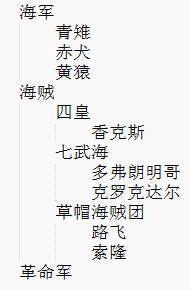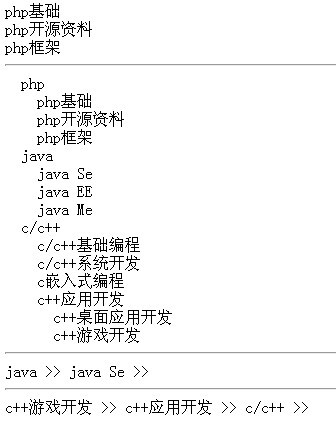create table onepiece(id int auto_increment,pid int not null,name varchar(225) not null,primary key(id));插入测试数据:
insert onepiece values(1,0,"海军"),(2,0,"海贼"),(3,0,"革命军"),(4,1,"青雉"),(5,1,"赤犬"),(6,1,"黄猿"),(7,2,"四皇"),(8,2,"七武海"),(9,2,"草帽海贼团"),(10,9,"索隆"),(11,7,"香克斯"),(12,8,"多弗朗明哥"),(13,8,"克洛克达尔");这里还是科普下海贼王里面的设定:世界分为三大阵营:海军,海贼,革命军。海军有大将:青雉,赤犬,黄猿。海贼有:四皇,七武海,草帽海贼团。四皇有香克斯,七武海有多弗朗明哥,克洛克达尔,草帽海贼团有索隆。(打个广告:海贼王真的很好看)。

下拉列表式

导航Link式
实例代码:
我封装了一个Unlimited类,用来调用diaplayList()展现下拉列表形式,调用diaplayLink展现导航Link分类。也可以增加(addNodes())和删除(deleteNodes)分类。
<?phpclass Unlimited{protected $mysqli;public function __construct($config){$this->mysqli=new mysqli($config["host"],$config["user"],$config["pwd"]);$this->mysqli->select_db($config["db"]);$this->mysqli->set_charset("utf8");if ($this->mysqli->connect_errno) {echo $this->mysqli->connect_error;}}private function getList($pid=0,&$result=array(),$spac=0){$spac=$spac+2;$sql="select * from onepiece where pid={$pid}";$rs=$this->mysqli->query($sql);while($row=$rs->fetch_assoc()) {$row["name"]=str_repeat(" ",$spac).$row["name"];$result[]=$row;$this->getList($row["id"],$result,$spac);}return $result;}/** * 展现下拉列表式分类 * @return [type]*/public function displayList(){$rs=$this->getList();$str="<select name="cate">";foreach ($rs as $key => $val) {$str.="<option >{$val["name"]}</option>";}$str.="</select>";return $str;}private function getLink($cid,&$result=array()){$sql="select * from onepiece where id={$cid}";$rs=$this->mysqli->query($sql);if($row=$rs->fetch_assoc()){$result[]=$row;$this->getLink($row["pid"],$result);}return array_reverse($result);}/** * 展现导航Link * @param [type] $cid [description] * @return [type] [description] */public function displayLink($cid){$rs=$this->getLink($cid);$str="";foreach ($rs as $val) {$str.="<a href="">{$val["name"]}</a>>";}return $str;}/** * 增加分类 * @param [type] $pid 父类id * @param [type] $name 本类名 */public function addNodes($pid,$name){$sql="insert into onepiece values("",{$pid},"".$name."")";if($this->mysqli->query($sql)){return true;}}/** * 删除分类 * @param [type] $id 本类id * @return [type]*/public function deleteNodes($id){$sql="select * from onepiece where pid ={$id}";$rs=$this->mysqli->query($sql);if($row=$rs->fetch_assoc()){$mes="还有子元素,请勿删除";}else{$sql="delete from onepiece where id={$id}";if($this->mysqli->query($sql)){$mes="删除成功";}}return $mes;}} 类中函数主要采取了递归函数的方法,如果理解深刻理解递归函数,其余的部分也就水到渠成了。我会在后面的部分详细介绍实现递归函数的三种方法。CREATE TABLE IF NOT EXISTS `category` (`categoryId` smallint(5) unsigned NOT NULL AUTO_INCREMENT,`parentId` smallint(5) unsigned NOT NULL DEFAULT "0",`categoryName` varchar(50) NOT NULL,PRIMARY KEY (`categoryId`) ) ;插入若干数据:
INSERT INTO `category` (`categoryId`, `parentId`, `categoryName`) VALUES (1, 0, "php"), (2, 0, "java"), (3, 0, "c/c++"), (4, 1, "php基础"), (5, 1, "php开源资料"), (6, 1, "php框架"), (7, 2, "java Se"), (8, 2, "java EE"), (9, 2, "java Me"), (10, 3, "c/c++基础编程"), (11, 3, "c/c++系统开发"), (12, 3, "c嵌入式编程"), (13, 3, "c++应用开发"), (14, 13, "c++桌面应用开发"), (15, 13, "c++游戏开发");下面是php代码:
<?php /* php无限极分类 *///获取某分类的直接子分类 function getSons($categorys,$catId=0){ $sons=array(); foreach($categorys as $item){ if($item["parentId"]==$catId) $sons[]=$item; } return $sons; }//获取某个分类的所有子分类 function getSubs($categorys,$catId=0,$level=1){ $subs=array(); foreach($categorys as $item){ if($item["parentId"]==$catId){ $item["level"]=$level; $subs[]=$item; $subs=array_merge($subs,getSubs($categorys,$item["categoryId"],$level+1));}} return $subs; }//获取某个分类的所有父分类 //方法一,递归 function getParents($categorys,$catId){ $tree=array(); foreach($categorys as $item){ if($item["categoryId"]==$catId){ if($item["parentId"]>0) $tree=array_merge($tree,getParents($categorys,$item["parentId"])); $tree[]=$item;break;} } return $tree; }//方法二,迭代 function getParents2($categorys,$catId){ $tree=array(); while($catId != 0){ foreach($categorys as $item){ if($item["categoryId"]==$catId){ $tree[]=$item; $catId=$item["parentId"]; break;} } } return $tree; } //测试 部分 $pdo=new PDO("mysql:host=localhost;dbname=test","root","8888"); $stmt=$pdo->query("select * from category order by categoryId"); $categorys=$stmt->fetchAll(PDO::FETCH_ASSOC);$result=getSons($categorys,1); foreach($result as $item) echo $item["categoryName"]."<br>"; echo "<hr>";$result=getSubs($categorys,0); foreach($result as $item) echo str_repeat(" ",$item["level"]).$item["categoryName"]."<br>"; echo "<hr>";$result=getParents($categorys,7); foreach($result as $item) echo $item["categoryName"]." >> "; echo "<hr>";$result=getParents2($categorys,15); foreach($result as $item) echo $item["categoryName"]." >> "; ?> 看下最终结果吧
虽然本文介绍的是使用递归来实现的无限级分类,但实际上,并不推荐大家这么做,大家知道分类多了,递归效率也就低了,本文这里仅仅是为了让大家更好的理解递归才这么做的。